بازدید امروز :139
بازدید دیروز :321
کل بازدید :392185
تعداد کل یاداشته ها : 1567
04/4/25
12:12 ع
Marmoset بوزینه
The common marmoset (Callithrix jacchus), known only from the Amazon rainforest of northeastern Brazil, is one of only seven marmoset species. This marmoset is omnivorous, feeding on flowers, fruits, nectar, tree sap and gum, insects, spiders, lizards, amphibians, snails, and other small invertebrates.

BarbaryApe
The barbary ape, Macaca sylvana, or macaque, native to Morocco and northern Algeria, and introduced into Gibraltar, is found in middle and higher elevation forests, scrublands, and cliff areas. This ape is both terrestrial and arboreal, and grows to a weight of 11 to 15 kg (23 to 33 lb). It eats roots, leaves, bark, fruit, and even small invertebrates.
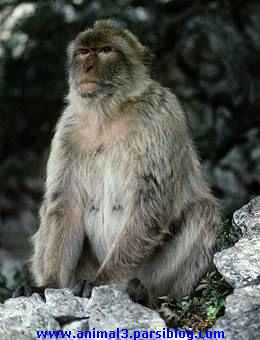
Capuchin Monkey
Capuchin Monkey, small mammal, any of four species of monkey familiar as the “organ-grinder” monkey. Capuchins are found in the tropical forests of Central and South America. The name is derived from the cap of dark hair on the monkey"s crown, which resembles the cowl worn by a Capuchin monk. One species also has tufts of hair on its head. The sturdy, roundheaded capuchins are about 30 to 55 cm (12 to 22 in) long, with a hairy, slightly prehensile tail of the same length. The tail is usually carried coiled at the tip—hence the alternative name, ringtail monkey. The monkeys are active by day and go about in troops, mainly in the tops of tall trees, feeding on fruits and small animals. There is a fairly rigid social hierarchy among both male and female capuchins. The dominant male helps to break up some fights, but other individuals also assist. Members of the troop may sound an alarm call to warn of an approaching enemy.
Scientific classification: Capuchins make up the genus Cebus of the family Cebidae, order Primates. The tufted species is classified as Cebus apella.
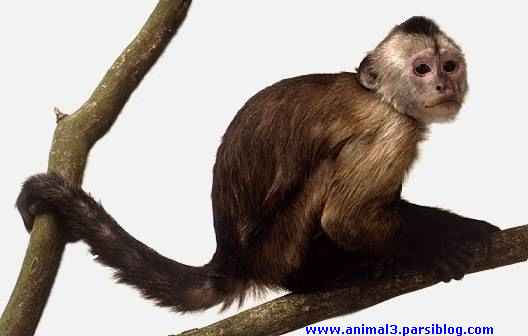
Baboon
The chacma baboon of southern Africa is one of at least three races of the savanna baboon. A forest-floor dweller, the chacma baboon is omnivorous, feeding on seeds, fruits, grasses, cultivated crops, insects, and small, young mammals. The call of another species, the olive baboon, can be heard here.
Baboon, common name applied to certain large African monkeys and sometimes to the closely related gelada. Most baboons are adapted to life on the ground and avoid forests; they range in large herds, called troops, over rocky, open lands and wooded areas of Africa and the Arabian Peninsula.
Baboons are powerful and aggressive animals about the size of a large dog. They have strong, elongated jaws, large cheek pouches in which they store food, and closely spaced eyes. They have pronounced brow ridges and strong limbs. Baboons can distinguish colours and have a keen sense of smell. They have large, often brightly coloured, hairless areas on their buttocks, and thick, sturdy legs. The tail of the mandrill and drill is generally short and is carried high in an arch.
Baboons eat various worms, eggs, insects, reptiles, crabs, molluscs, small mammals, fruits,flamingo, and young shoots. Baboon troops usually number from 30 to more than 100 members. Baboons have several different calls, many of which have specific meanings. After a gestation period of about six months, a female usually bears a single offspring, which clings to its mother"s underside. Rarely a female has twins.
The largest of the baboons is the chacma (a kind of mandrill) of southern Africa. Known also as the pig-tailed baboon, it is greyish-brown with a green tint along the back. The adult male may weigh up to 41 kg (90 lb) and is a formidable fighter against the troop"s enemies.
The olive baboon is found in the sub-Saharan savannah region extending from Mali to Ethiopia and northern Tanzania, and is also found in several mountainous regions of the Sahara desert. It has a darker brown coat than that of the chacma.
The yellow baboon is native to western, central, and eastern Africa, south to Mashonaland in Zimbabwe. The several subspecies of these baboons all have light yellow coats and blackish faces.
Another well-known species is the North African hamadryas baboon of northern Africa and the south-western Arabian Peninsula. It is known as the “sacred baboon” because it was deified by the ancient Egyptians. It has a pink face and a long snout, and males have a long mane covering the neck and shoulders.
The mandrill, a large baboon of western Africa, has an enormous head, crested and bearded, and almost no forehead. Another western African species is the drill, somewhat smaller than the mandrill, but similar in its lack of aggressive behaviour. The gelada, the only true primate grazer, spends the night sleeping in the cliffs of gorges in central Ethiopia.
Scientific classification: Baboons belong to the family Cercopithecidae. The chacma is classified as Papio ursinus, the olive baboon as Papio anubis, the yellow baboon as Papio cynocephalus, the hamadryas baboon as Papio hamadryas, the mandrill as Papio sphinx, the drill as Papio leucophaeus, and the gelada as Theropithecus gelada. In some classification systems the
mandrill and drill are not classified as baboons but are placed in a closely related genus, Mandrillus.
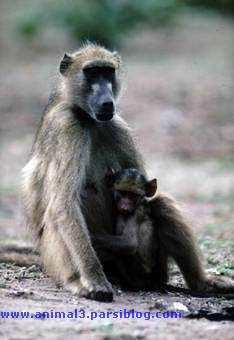
Genetزباد
Genet, common name for certain small carnivorous, cat-like mammals related to the civet. Genets inhabit forests and dense grasslands throughout Africa; one species is also found in south-western Europe and western Asia. The colour is pale yellow or grey, with rows of brown or black spots and a stripe down the back and tail. Some species have banded tails. The animal"s length varies from 42 to 58 cm (17 to 23 in), and the tail may be almost as long as the body. Genets hunt at night, singly or in pairs, and prey on small mammals and birds. In the wild they may only live for up to ten years, but in captivity they have been known to live for as long as 21 years.
Scientific classification: Genets make up the genus Genetta. The genet found in Europe and Asia is classified as Genetta genetta.
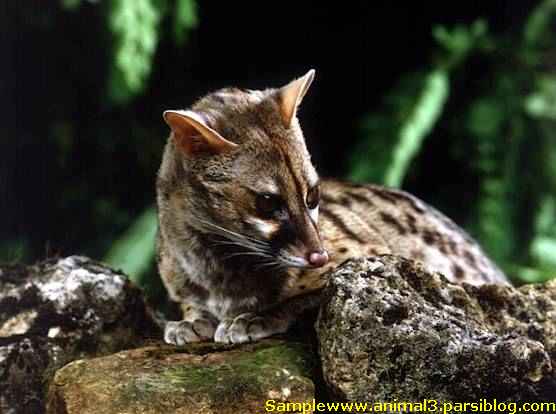
Colobus Monkey
The colobus monkey, found only in Africa, is the only monkey that has a stomach similar to that of a cow. Its stomach has three or four compartments and is adapted to digest its exclusive diet of leaves. In addition to being hunted for its fur, one of its main enemies is the chimpanzee.
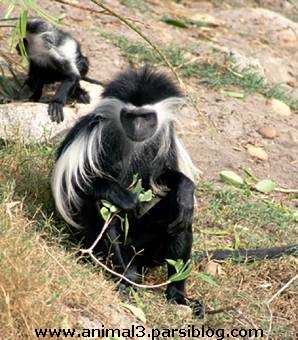
پوما Puma
پوما Puma
Puma, also cougar, panther, or mountain lion, carnivore of the cat family from North and South America with thick fur that ranges from reddish-brown in tropical forms to bluish-grey in northern forms. It is lighter on the sides, and the muzzle, chin, throat, breast, and insides of the legs are whitish. The puma is found from British Columbia to Patagonia. Its body can be up to 1.95 m (6y ft) long, exclusive of its long tail. The head is relatively small, with a black spot above each eye. The female bears two to four young in a litter; the young have dark brown spots on the back, and the tail is ringed. Pumas hunt elks, deer, and smaller mammals. Because ranchers suspect them of killing cattle, the animals have been exterminated or are endangered in many areas.
Scientific classification: The puma belongs to the family Felidae. It is classified as Puma concolor.

